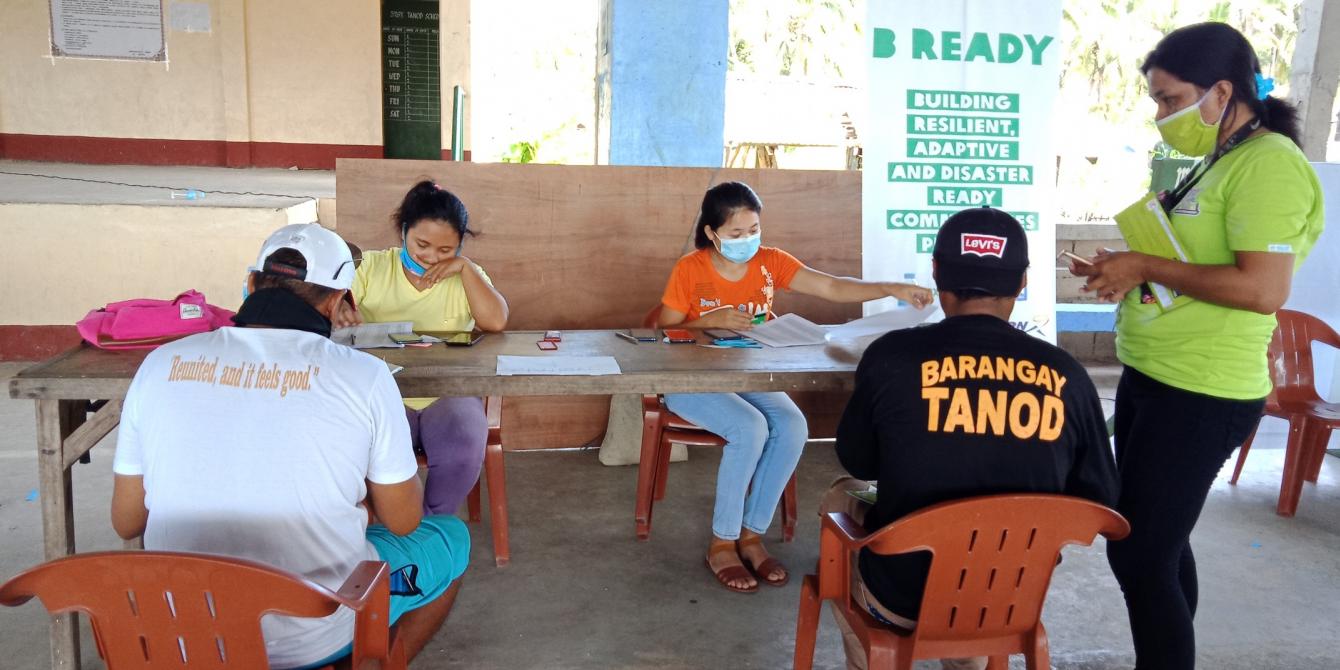Climate science meets participatory pre-disaster response

Distribution of iAFFORD Cards to project participants in Barangay Matarinao, one of the priority areas of the B-READY Project. (Photo: PDRRN)
“Everything begins with the science,” says Global Parametrics founder Professor Jerry Skees.
Formed in 2016, Global Parametrics combines climate science, data modeling and financial engineering to create the much-needed tools that can help understand, manage and mitigate the risks brought about by natural disasters.
Based in London, United Kingdom, Global Parametrics is already much sought after as a world expert indesigning, structuring, and deploying global solutions by a team of scientists, risk modelers and computerscientists, as well as practitioners of developmental finance, commercial insurance and fund management.
B-READY was Global Parametrics’ first involvement in a project that values and operationalizes communityparticipation in anticipatory financing for DRR.
“B-READY combines forecast technology, cash payment, and community participation that includes identification of vulnerable households, community consultations and drills,” says Smith.
Citing her group’s vast experience in developing sustainable financing mechanisms for natural hazards andextreme weather risk in developing economies, Smith points out how B-READY is an innovation that othercountries and vulnerable communities can replicate. She says financing institutions should seriously considerexploring and adapting to it.
Smith recalls how communities on the ground were willing to take time to learn and how the local government of Salcedo municipality took an active role and was very willing to share its learnings on how the program worked.
“The parametric tools and index are usually difficult concepts to understand, but the community-basedlearning approach made it possible for leaders and the people to take in the concepts and know how to use them,” she notes.
“We provide the technology, but the community’s collective pre-identification of households and the drills make what we bring in truly worth it and very valuable,” she adds.
To make the engagement as collaborative as possible, a workshop was conducted in January 2020 in Salcedo. Through the workshop and community feedback that followed, Global Parametrics implemented adjustmentsthat included the following:
- The forecasting index was simplified by converting it to simple instruments, such as color codes, whichare already familiar to the community.
- Common terminology was associated with index values. Different levels of wind speeds were mapped to visualize the danger experienced by locals. Simplified language such “very likely,” “likely,” “moderate,”“unlikely” and “very unlikely,” or “almost certainly,” “1-in-4 rate of failure,” “average rate of success,” “1-in-4 rate of success” and “almost never” were considered.
- The B-READY forecasting index was mapped to align with existing EWS for consistency with thelevels of the index defined by the stakeholders and current government guidelines.
- To coordinate with similar forecasting efforts, another tropical cyclone forecasting by institutions wasprovided with B-READY workshop participants’ outputs.
- Forecasting index was calibrated to local data with two categories: hazard and impact data. Theforecasting index was calibrated based on all the available hazard data gathered from various internationalagencies. Historical data from PAGASA dating 60 years back on the impact of typhoons on Salcedo, EasternSamar were collected and integrated later into the index.
- Triggering thresholds were calibrated based on the historical experiences of the locals in Salcedo. Thefinal values were later established based on the impact data (damage, false vs. true evacuation) that were collected.
- All limitations and uncertainties of the forecasting model were disclosed to all stakeholders.
For the next phase, Smith sees the planned scale-up to involve the national government and otherinstitutions as very promising. “The community model worked very well. Being able to work withhumanitarian partners such as Oxfam is rewarding,” she says.
On the technology side, Wendy says Global Parametrics “saw what is possible.” Her group also “saw what is not possible as of the moment but can be developed in the future.”
“Anticipatory finance does work — there is an area for growth for these kinds of programs within thehumanitarian space,” she declares.
###
The Building Resilient, Adaptive, and Disaster-Ready Communities (B-READY) Project is a two-year pilot project that aims to better protect vulnerablehouseholds from natural disasters through a pre-disaster cash transfer program using two innovations: first, the use of digital weather forecasting and risk modeling technologies as part of the local communities’ early warning systems (EWS) and trigger mechanisms for early response; and second, the use of financial services provision technologies and a local financial ecosystem that would allow for safe and secure pre-disaster cash transfer programming.
The B-READY project was a collaboration of a consortium of partners, namely: Local Government of Salcedo, Eastern Samar; People’s Disaster Risk Reduction Network; PayMaya Philippines; Global Parametrics; and Plan International. Over the past two years, the project reached almost 9,300 individuals in nine barangays (villages) in Salcedo with access to digital financial services, literacy trainings, and pre-disaster cash grants for two devastating typhoons; supported theaccreditation of 17 community-based cash agents for disbursement of cash grants; jointly developed and tested the triggers of typhoon parametric index; strengthened safeguarding mechanisms during emergencies; and facilitated local government adoption of a resolution for using parametric index as part of disaster EWS.

 Follow us on Facebook
Follow us on Facebook Instagram
Instagram Follow us on Twitter
Follow us on Twitter LinkedIn
LinkedIn